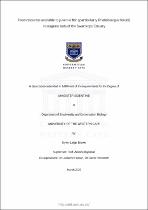| dc.contributor.advisor | Rajkaran, Anusha | |
| dc.contributor.author | Brown, Kylen Leigh | |
| dc.date.accessioned | 2023-05-18T07:34:14Z | |
| dc.date.available | 2023-05-18T07:34:14Z | |
| dc.date.issued | 2023 | |
| dc.identifier.uri | http://hdl.handle.net/11394/10024 | |
| dc.description | Magister Scientiae (Biodiversity and Conservation Biology) | en_US |
| dc.description.abstract | Estuarine habitats are critical nursery areas for many species of marine fishes during their early life stages in terms of food availability and structural complexity, which increases survival and growth rates. The Cape stumpnose Rhabdosargus holubi is one of the most abundant marine fish species found in estuaries along the south-east coast and depends on estuaries as exclusive nursery habitats. This study aimed to identify the epiphytic diatom and macrofauna food resources available to R. holubi in the seagrass Zostera capensis habitat of the Swartkops Estuary. This habitat has been identified as a core nursery area for this species through a combination of greater abundance, higher growth and survival of juveniles. This study compared what was found in the seagrass habitat and assessed whether this habitat provided for the prey resources most commonly observed in the diet of R. holub. | en_US |
| dc.language.iso | en | en_US |
| dc.publisher | University of the Western Cape | en_US |
| dc.subject | Food availability | en_US |
| dc.subject | Juvenile marine fish | en_US |
| dc.subject | Nursery area | en_US |
| dc.subject | Diatoms | en_US |
| dc.subject | Invertebrates | en_US |
| dc.title | Food resources available to juvenile fish (particularly rhabdosargus holubi) in seagrass beds of the swartkops etuary | en_US |
| dc.rights.holder | University of the Western Cape | en_US |

